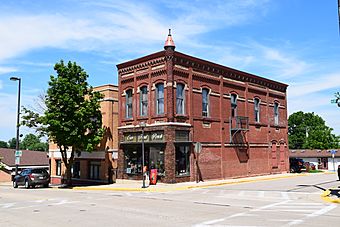Iowa Street Historic District facts for kids
Quick facts for kids |
|
|
Iowa Street Historic District
|
|

A portion of the district.
|
|
| Location | Roughly, Iowa St. from Division St. to Diagonal St., Dodgeville, Wisconsin |
|---|---|
| Area | 9 acres (3.6 ha) |
| NRHP reference No. | 96000991 |
| Added to NRHP | September 6, 1996 |
The Iowa Street Historic District is a special area in Dodgeville, Wisconsin, United States. It's like a time capsule, showing how the town looked and grew over many years. This district is important because it has many old buildings that tell stories about the past.
Contents
Discovering the Iowa Street Historic District
Imagine walking down a street where every building has a history! That's what it's like in the Iowa Street Historic District. This area is recognized as a historic place because it has many buildings that are old and special. They show different styles of architecture from long ago.
What Makes a Historic District Special?
A historic district is a group of buildings, structures, or other objects that are important together. They might be important because of their history, their architecture, or what they represent. The Iowa Street Historic District is special because it includes many of Dodgeville's original downtown buildings. These buildings show how people lived and worked in the past.
A Walk Through Time: Buildings of Iowa Street
The Iowa Street Historic District covers about 9 acres. It's home to several buildings that were built between the mid-1800s and the mid-1900s. Each building has its own unique look and story.
The Old Courthouse: A Glimpse of History
One of the oldest and most important buildings is the Greek Revival Iowa County Courthouse. It was built in 1859. The Greek Revival style looks a bit like ancient Greek temples, with grand columns and a strong, formal design. This building was the center of local government for many years.
From Hardware to Opera: Other Cool Buildings
As you walk through the district, you'll see other interesting buildings:
- The Ford hardware store, built in 1888, shows off the Italianate style. This style often features tall, narrow windows and decorative brackets under the roof.
- The Auditorium, built in 1901, was once an opera house! It's designed in the Queen Anne style. This style is known for its fancy details, towers, and different textures. Imagine people going there to watch shows over a hundred years ago!
Modern Touches: Later Buildings
Even buildings from the early 1900s are part of this historic area:
- The First National Bank, built in 1919, is in the Neoclassical style. This style is also inspired by ancient Greek and Roman buildings, but it's often more simple and grand than Greek Revival.
- The Pollard harness shop, from 1922, is an example of Commercial Craftsman style. This style often uses natural materials and has a sturdy, handcrafted look.
- The Commonwealth Telephone Company building, built in 1940, shows the Art Deco style. Art Deco is famous for its sleek lines, geometric shapes, and often shiny materials, representing a more modern look.
These buildings together create a picture of Dodgeville's past, showing how architecture and daily life changed over many decades.

